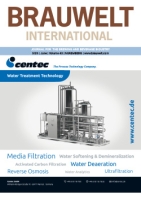Creative and innovative beer combinations with non-alcoholic beverages make modern beer mix beverages an innovative product segment in Germany. Based on a long tradition, beer lends itself as a base for new and modern mixed beverages – for example shandy or cola beer- and offers attractive growth potential for German breweries.
The beer market in Germany and almost all the countries of Western Europe is marked by a downward trend in the consumption of beer. In addition there is a great deal of pressure from the concentration of the trade and certain sectors of it. This situation will not improve in the near future but, rather, will intensify. New strategies are needed, together with new products and services.g. herbs, vitamins, taste components, alcohol content, etc.
This paper covers U.S. American and Canadian non-alcoholic (NA) malt beverages tested in our Weihenstephan Institute between 1980 and 1997. It is well known that the term "non-alcoholic" is not allowed in these two countries. The maximum permissible alcohol level in NA malt beverages is 0.5 vol.%.
This article describes new industrial production concepts for non-alcoholic malt-based beverages/functional drinks for the international beverage industry. These open up new possibilities for utilising existing production capacities in breweries.
Beer consumption continues to drop, the tendency is increasingly towards "non-alcoholic". In the wake of the big success of traditional beer-based beverages such as shandy, an obvious move was to mix non-alcoholic beer with soft drink components in order to sell it opportunely, as e.g. "non-alcoholic shandy" or also as an isotonic thirst quencher.
The continuous process monitoring in the production of sugar-free soft drinks demands considerably more of measuring systems than is the case with sugared drinks. Digital density measurement in combination with rapid, high-precision temperature and CO2 measurement has proven to be a robust and highly accurate method for the process control of sugar-free and sugared soft drinks.
Coca-Cola HBC (CCHBC), the world’s second largest Coke bottler, reported consolidated nine months net profits of 38.5 million Euro against a break-even position last year. Sales were up 12 percent to 2.69 billion Euro.
Important selective characteristics, such as a low pH value and a high CO2 content, largely protect alcohol-free beverages from microbial spoilage. However, due to the omnipresent conidiospores moulds (particularly Penicillium spp.), non-sparkling beverages require pasteurisation under gentle conditions (Fig. 2).
Together with blending and carbonation, degassing of liquids plays a key role in the soft drinks production process.


